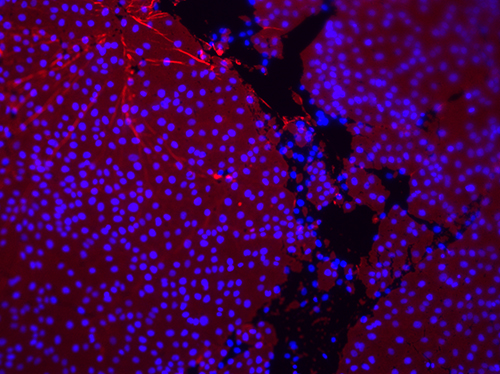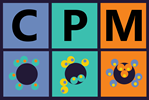Underpinning Bioengineering

Work from Prof Gautrot showing cells proliferating on nanosheets self-assembled at liquid-liquid interfaces
Researchers in the Centre for Predictive in vitro Models are actively engaged in Bioengineering research that underpins the development of new in vitro models and organ-on-a-chip technology. This includes aspects of biomaterials, manufacture, 3D printing and microfluidics. This area of work links closely with the Queen Mary Institute of Bioengineering and the Bioengineering Division within the School of Engineering and Materials Science.
In addition, Queen Mary University of London has a critical mass of researchers in the area of Mechanobiology, exploring the effects of mechanical stimuli on cell function. This requires understanding of the physiological and pathological biomechanics and the development of bioengineering technology to apply these stimuli within the context of predictive in vitro models. In addition mechanical stimuli in the form of physical or topographical cues may be used within in vitro models to drive cell differentiation and the production of physiologically relevant extracellaular matrix.
People
- Prof Julien Gautrot
Theme Lead for Underpinning Bioengineering
Professor of Biomaterials and Biointerfaces, Queen Mary University of London - Prof John Connelly
Professor of Bioengineering, Queen Mary University of London - Dr Marc Fernandez-Yague
Lecturer in Chemistry, Queen Mary University of London - Prof Karin Hing
Baxter/Royal Academy of Engineering Research Chair in Biomaterials and Tissue Regeneration, Queen Mary University of London - Prof Thomas Iskratsch
Professor of Cardiovascular Mechanobiology and Bioengineering, Queen Mary University of London - Dr Ahmed Ismail
Lecturer in Fluid Dynamics, Queen Mary University of London - Prof Martin Knight
Professor of Mechanobiology, Dean for Research, Queen Mary University of London - Prof Steffi Krause
Professor of Electroanalytical Systems, Queen Mary University of London - Prof David Lee
Professor of Cell & Tissue Engineering, Queen Mary University of London - Dr Yung-Yao Lin
Senior Lecturer, Queen Mary University of London - Prof Venet Osmani
Professor of Clinical AI and Machine Learning, Queen Mary University of London - Prof Matteo Palma
Professor of Physical Chemistry and Nanomaterials, Queen Mary University of London - Dr Marco Pensalfini
Lecturer in Mechanical and Biomedical Engineering, Queen Mary University of London - Prof Hazel Screen
Professor of Biomedical Engineering, Queen Mary University of London - Prof Julia Shelton
Professor of Biomechanical Engineering, Queen Mary University of London - Prof Greg Slabaugh
Director of the Digital Environment Research Institute, Queen Mary University of London - Prof Zion Tse
Academy of Medical Sciences Professor in Bioengineering, Queen Mary University of London - Dr Stefaan Verbruggen
Lecturer in Medical Technology, Queen Mary University of London


